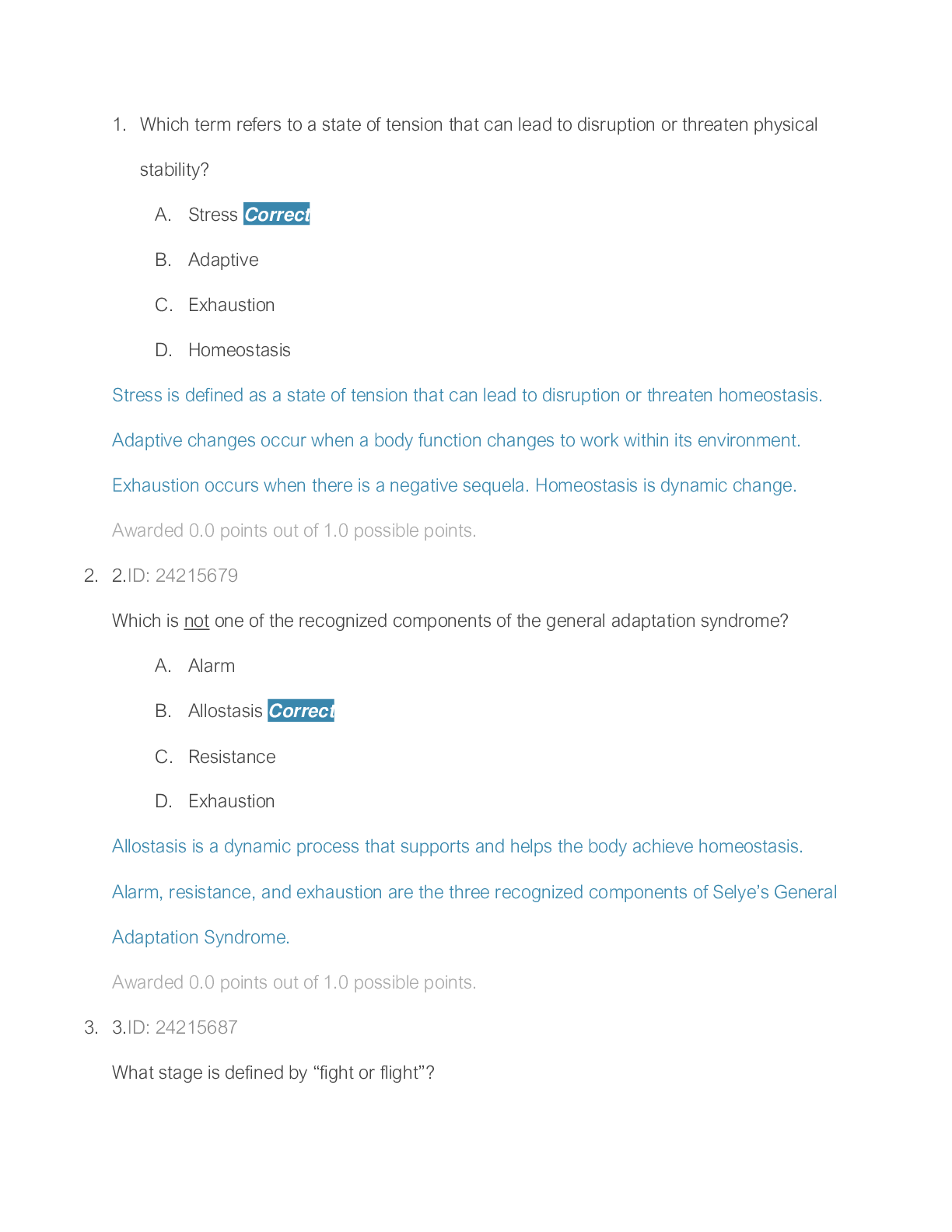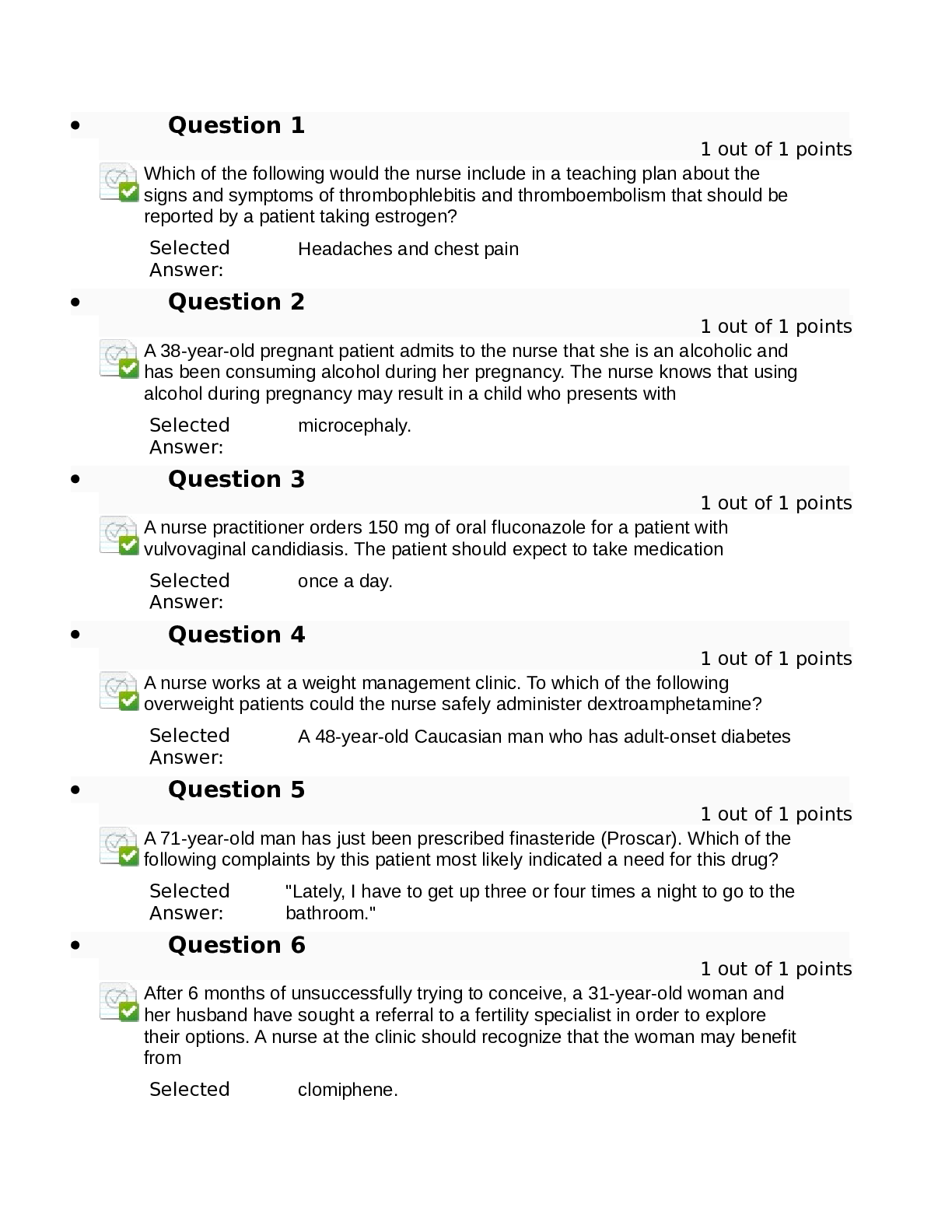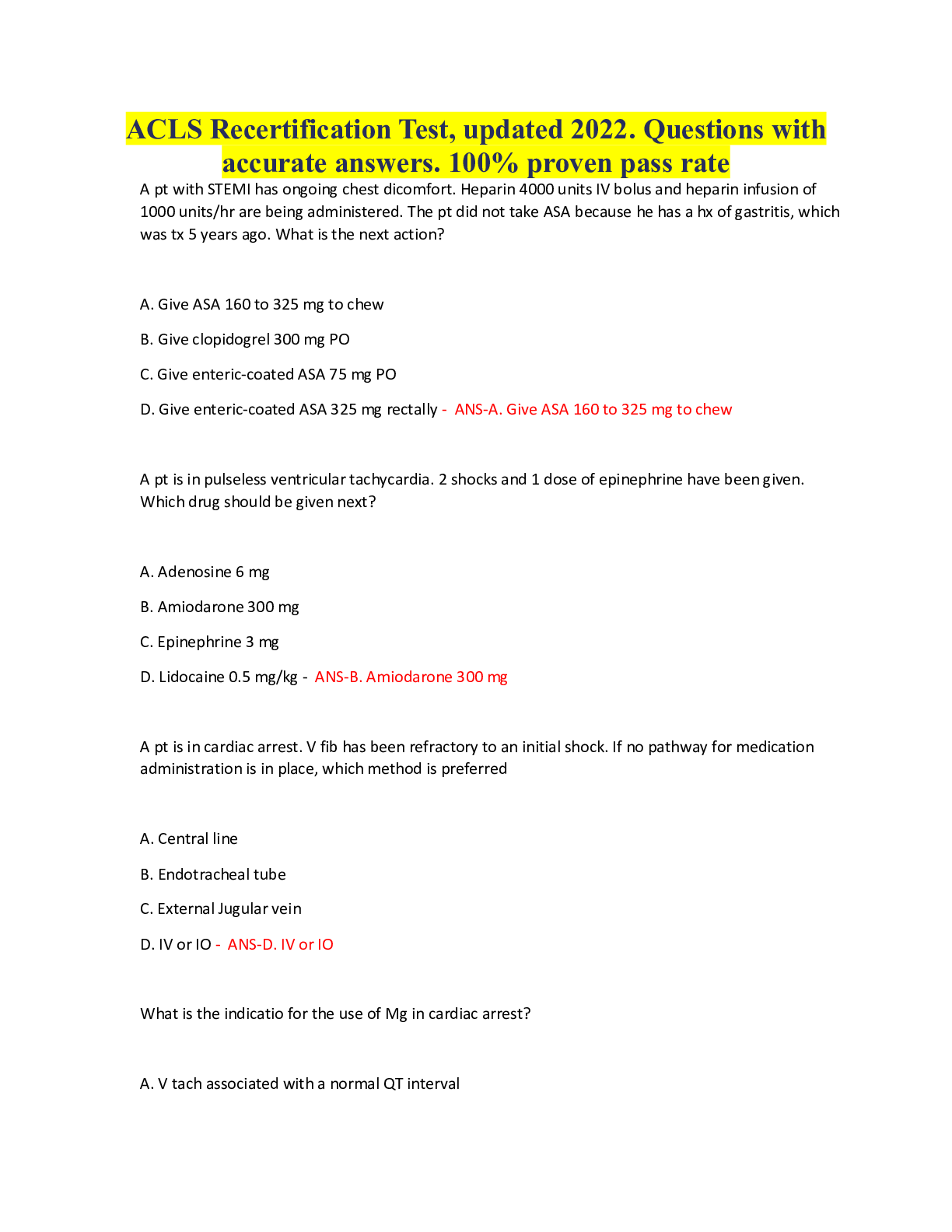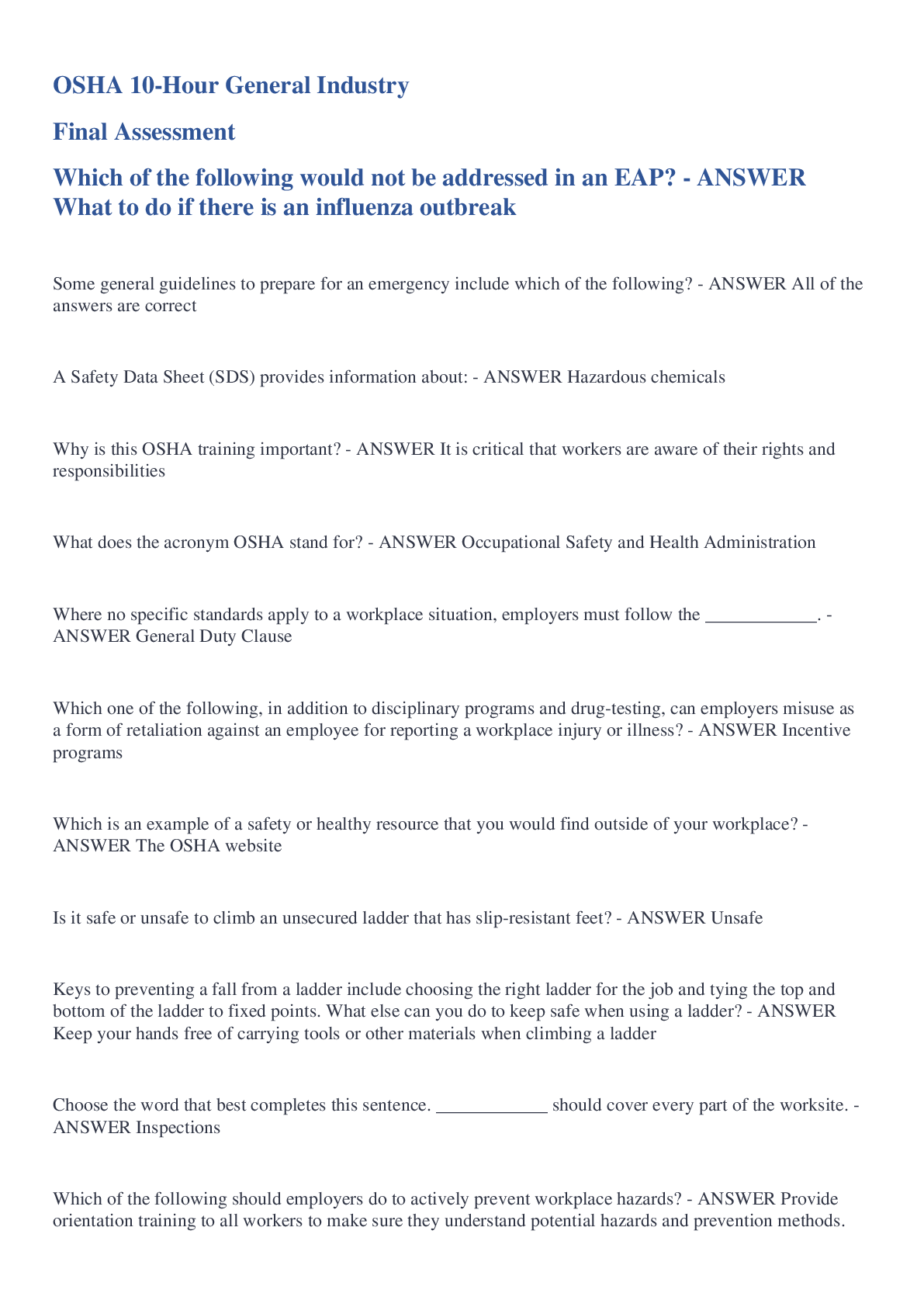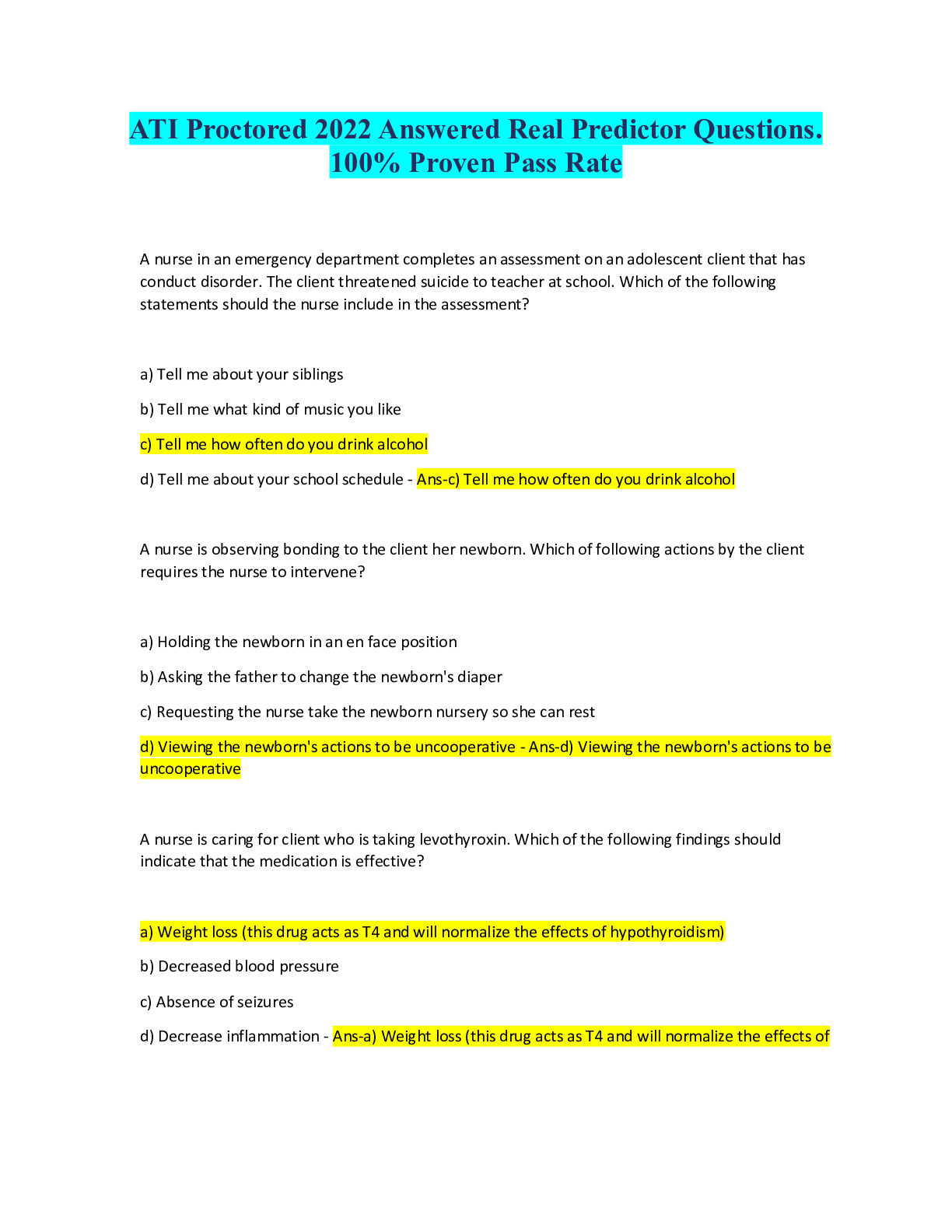*NURSING > QUESTIONS & ANSWERS > FNP pre-test Review, Questions and answers, Rated A+. 100% proven pass rate. (All)
FNP pre-test Review, Questions and answers, Rated A+. 100% proven pass rate.
Document Content and Description Below
FNP pre-test Review 1. (2) You are reading an evidence based article published in a refereed journal and note a confidence interval (CI) related to the following statement: “Terminally ill bone c... ancer patient in the final stages of illness have several episodes of illness have several episodes of nausea every 24 hours.” Which of the following is true? a. The smaller the CI, less value deviate from the mean b. The larger the CI, the more precise the range of values c. The smaller the CI, the more deviates from the mean d. The smaller the CI, the more precise the range of values. *A smaller CI indicates more precise the information. The CI is a specified probability that includes the parameter being estimated. 2. (5) Brenda, 57, is a mother of three and was diagnosed with Prinzmetal’s angina. Which medication classification is most indicated for this patient’s treatment and control? a. Glycoprotein IIb/IIa inhibitors b. Angiotensin II converting enzyme inhibitors c. Beta blockers d. Calcium channel blockers *Prinzmetal’s angina is the result of coronary vasospasm, rather than atherosclerosis. Prinzmetal’s (variant) occurs at various times, including rest. Levine’s sign—“clenched fist sign” 90% diagnostic for angina. ST elevation on MI and Prinzmetal’s (p. 315) 3. (20) A caretaker is taking an Alzheimer’s patient for a walk and hands him his jacket. However, the patient merely looks back at the caretaker and stares, as though he is confused. What should the caretaker do? a. Put the jacket on the patient b. Assume that the patient doesn’t need that coat and continue the walk c. Cancel the walk and reschedule for another time. d. Remind the patient by telling him to put his jacket on again. *Patient seemingly confused state describes a classic example of apraxia, the inability to perform a previously learned task. Apraxia is a common finding of AD. 1A reminder would not lead the patient to put on the jacket as he has forgotten how to complete the task at hand. 4. (25) You are examining an infant with red-brown vesiculopapular lesions and curved burrows on the head, neck, palms and soles. The infant appears to have sensations of intense itching. Which of the following dermatologic conditions is the most likely cause of the infant’s findings? a. Scabies b. Molluscum contagiosum c. Atopic dermatitis d. Varicella zoster *Unlike scabies in adults, infants patient do not present with lesions on the skin folds. The presence of curved burrows help to distinguish scabies from varicella zoster virus. (p. 102) Scabies is highly contagious skin infestation caused by parasitic mite that burrows into stratum corneum. Spread through the direct or indirect contact with personal item. S/S: intense itching, irritability in infants, linear curved burrows. Infants—red-brown vesiculopapular lesions on head, neck, palms, or soles. Older children—red papules on skin folds, umbilicus, or abdomen (hand between fingers). 5. (28) You have been assisting a patient with AIDS over the past year. What medication does an AIDS patient usually take daily for Pneumocystis jirovecii pneumonia prophylaxis? a. Penicillin G b. Trimethropin-sulfamethoxazole c. Valacyclovir d. Azithromycin *Bactrim for Pneumocystis jirovecii pneumonia prophylaxis (p. 238). 6. (29) Susan, a 47-year-old female, presents with blue sclera, a triangular face, and complaints of a loss of hearing. Based on these manifestations, which of the following genetic disorders would you attribute to Susan? a. Osteogenesis imperfect b. Valgum syndrome 2c. Rhett syndrome d. Femoral retroversion bilaterally *Osteogenesis imperfect type I characteristic include: bone that fracture easily, predisposing family history; near normal or slightly shorter stature, blue sclera, dental problems, triangular face, tendency toward spinal curvatures, hearing loss beginning in early 20-30s; most fractures occur before puberty. Rhett syndrome characterized by reversals in expressive language and hand movement and the patient would have experienced symptoms very early in childhood. 7. (30) You specialize in caring for the elderly and are concerned about a recent spike of suicide in the elderly community. What are the two major reasons that the elderly commit suicide? a. Dementia and overmedication b. Medical disability and loneliness c. Poor support system and future uncertain d. Financial instability and lack to access care. *Statistic show that in the elderly loneliness and medical disability are the two major reasons for suicide. 8. (32) You are monitoring a toddler who has serous otitis media. The parents want to understand the treatment their child will receive. Which of the following would be the most appropriate way to manage this condition? a. Antihistamines b. Monitor and re-evaluate in three months c. Decongestants d. Oral antibiotics *Oral antibiotics are not typically used to treat serous otitis media since this condition does not have a bacterial pathology a majority of the time. (p. 113) Management: watchful monitoring for three months; antibiotic therapy no longterm efficacy, antihistamines/decongestants ineffective. Re-evaluate in three to six months. 39. (33) A 24-year-old patient presents to your office with complaints of fatigue, headaches, and a recent onset of a very pale complexion. Upon examination, you note her tongue appears very smooth and has absence of papillae. When you question the patient about her diet, she tells you that she frequently skips meals and tends to eat fast food on the times when she does eat. What is the most likely diagnosis? a. Pernicious anemia b. Sickle cell anemia c. Folic acid deficiency d. Anemia of chronic disease *Folic acid deficiency is caused by an inadequate intake/malabsorption of folic acid. Patient seemingly anorexic eating habits and symptoms most indicate this condition. Pernicious anemia also causes glossitis, however, the patients dietary habits indicate folic acid deficiency. (p.270) 10. (35) A 45-year-old goat farmer presents with an unusual lesion on his left arm. He explains that the lesion started out as a harmless, painless, itchy blister, but has since turned into a large, black scab surrounded by lots of swelling. An exam also reveals purulent discharge. You order a skin culture. Of the following, what is the most likely diagnosis? a. Seborrheic keratosis b. Malignant melanoma c. Cutaneous anthrax d. Small pox *Farmer are especially at risk of exposure to infection since farm animals, such as goats, can be infected with anthrax. (p. 218) S/S: Cutaneous (most common, 95% of cases); occurs on exposed areas on the arms and hands, followed by face and neck, pruritic papule leading to ulcer surround by vesicles, develops into black necrotic central eschar with edema, after 1-2 weeks, eschar dries, loosens, separates, leaving a permanent scar, regional lymphadenopathy. Lab: gram stain of specimen. Tx. Vaccine for those at risk. Antibiotics: penicillin, Ciprofloxacin, Doxycycline. Report to health department. 411. (37) A nurse practitioner in a family practice clinic is examining a 40-year-old patient who has recently gained 15 pounds. The patient is concerned that her diaphragm, otherwise known as a cervical cap will not be as effective because of her weight gain. Which of the following indicates the minimum weight gain thresh hold for when women would most likely need to see their healthcare provider about refitting their diaphragm? a. One to five pounds b. Then to twenty pounds c. Twenty to thirty pounds d. Five to ten pounds. *Diaphragm users should see their healthcare provider when they have gained 10-20 lbs. Also regularly check their device for holes and refrain from using oilbased lubricants. 12. (38) You are performing a quad screen on a pregnant patient. Which component of the screen is most telling in detecting Down syndrome? a. Alpha-fetoprotein b. Human chononic gonadotropin c. Estriol d. Amniotic fluid *Lower than normal AFP levels usually indicate a higher chance of Down syndrome. 13.(39) Scientist do not yet fully understand what causes Alzheimer’s disease, but it is clear that this disease develops because of a complex series of events in the brain over a long period of time. The likely causes of Alzheimer’s includes genetic, environmental, and lifestyle factors. One theoretical cause is an improper balance and function of neurotransmitters in the brain. Which of the following conditions is considered a causal factor of this aspect? a. Acetylcholine deficiency b. Serotoing excess c. Dopamine deficiency [Show More]
Last updated: 1 year ago
Preview 1 out of 14 pages
Instant download
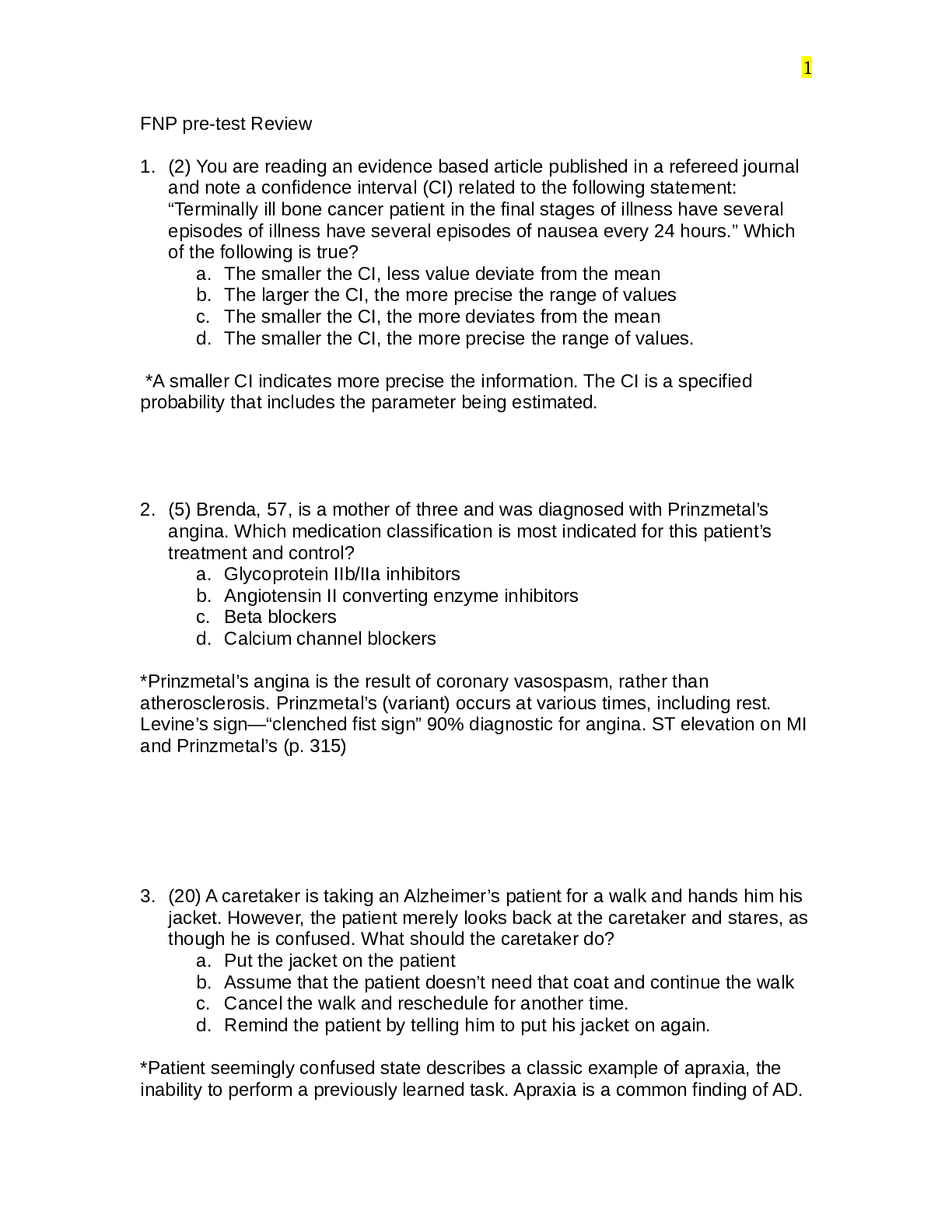
Buy this document to get the full access instantly
Instant Download Access after purchase
Add to cartInstant download
Reviews( 0 )
Document information
Connected school, study & course
About the document
Uploaded On
Aug 29, 2022
Number of pages
14
Written in
Additional information
This document has been written for:
Uploaded
Aug 29, 2022
Downloads
0
Views
79













